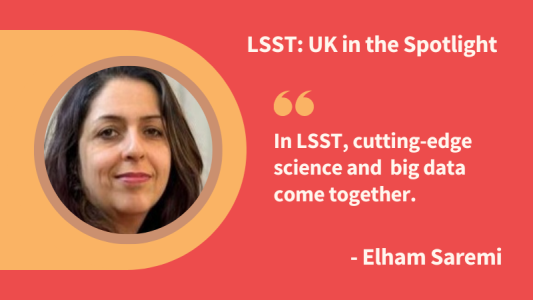In the Spotlight: Elham Saremi
Published 11 August 2025

We grabbed 5 minutes with Elham Saremi to ask her about her work.
Dr Elham Saremi is a Research Fellow at the University of Southampton and works on the LSST–VISTA fusion dataset, which involves developing a pipeline to perform forced photometry of LSST optical bands using VISTA/VIRCAM near-infrared data.
The goal is to produce high-quality multiwavelength datasets that support a wide range of scientific projects, including studies of galaxy evolution, stellar populations, and time-domain phenomena.
What excites you most about the Rubin LSST?
What excites me most is the unprecedented depth and coverage of the Rubin LSST data – capturing half the sky with such depth will be truly transformative. It has the potential to revolutionise our understanding of the Universe, from mapping dark matter to uncovering the faintest galaxies and transients. This scale of data will open up discoveries we can’t even predict yet.
What's the best thing you've learned while working on LSST:UK?
One of the best things I’ve experienced is the value of strong teamwork within LSST:UK.
The excellent coordination between all the participating universities have shown me how effective collaboration can really drive a large-scale scientific project forward.
How did you get into astronomy?
I’ve been working in astronomy since I started my PhD. That marked the beginning of my journey into observational astronomy and data analysis. I began by working with the 2.4-metre telescope at La Palma, studying around 60 dwarf galaxies in the local Universe. Over time, my interests expanded toward large surveys and the computational side of astronomy, which naturally led me to projects like LSST, where cutting-edge science and big data come together.
What's your favourite thing about working in research?
My main interest in astronomy is the study of Low Surface Brightness structures. What excites me most is the opportunity to discover new, faint features, such as tidal streams, extended halos, and ultra-diffuse galaxies, especially as deeper datasets and more advanced data analysis methods become available. Uncovering what was previously invisible is incredibly rewarding.
Do you have any advice for those who'd like to work in a similar area?
Be patient, curious, and persistent.
Working with astronomical data, especially on a large scale, can be challenging, but it’s incredibly rewarding when you reach a beautiful result.
Don’t be afraid to dive into the technical side, like programming and data analysis; these are powerful tools that unlock new discoveries. And most importantly, surround yourself with people who support and inspire you – science is always a team effort.